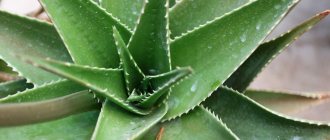What does Cereus Peruviana look like?
Cereus is one of the brightest representatives of the Cactus family. The succulent is distinguished by its large dimensions, good frost resistance and fruitful growth. The plant reaches a height of 20 m. Its root system is considered powerful and dense, and it develops very quickly. The succulent is often called Cereus Monstrosa.
Peruvian Cereus in a pot
There are sharp spines along the entire length of the flower. Their length varies within 3 cm. The central spines are in the form of a spike, their length reaches 10 cm.
Common varieties
The main types of cereus include:
- nocturnal cereus;
- Cereus Manga;
- Cereus spiralis;
- Cereus azure;
- Cereus giant.
- Cereus japonstrosus;
- Cereus yamakaru.
Important! Each variety of cactus crop requires specific growing conditions.
Cereus varieties
There are many types of cereus plants:
- Validus. The bluish stem and snow-white flowers of Cereus look very harmonious and aesthetically pleasing.
- Carnegia - its homeland is located in the desert American states, and the flower of this plant is a symbol of Arizona. This cactus produces reddish edible fruits. Cristata is a cactus native to Peru. Its trunks are spherical and grow tightly in relation to each other. Small spines grow from the ribs.
- Azureocereus. Its azure shade immediately attracts attention, as well as its fairly large stem with significant branching. One of the features of this variety of cereus is the corollas, which emit a strong aroma.
Peruvian Cereus: care at home
Cereus cactus: popular plant species and caring for them at home
Cereus cactus is a plant with good immunity. The speed and productivity of the growth of Cereus Peruvianus depend on caring for it at home. To properly maintain a flower, you need to familiarize yourself with the rules of watering, replanting and propagation.
Temperature
The owner should know that cactus cereus easily tolerates sudden temperature changes. It thrives in extreme heat and moderate cold. In winter, a succulent can develop normally at temperatures from 8 to 12 degrees. In summer, maximum values are around 30 degrees.
For fruitful growth, the cereus flower needs good air circulation, so periodically it needs to be taken out to the balcony (for 2-3 days).
Lighting
Cereus Peruvian loves good lighting, preferably natural. Gardeners advise placing the plant in the brightest place in the house.
The cactus can be left in direct sunlight in the summer. But here it is important not to overdo it, so that this does not lead to excessive dryness of the soil. From time to time you will need to bring it into the house and protect it from exposure to ultraviolet rays.
Watering
Cereus cactus loves moderate watering. Excess and lack of moisture can adversely affect the growth and flowering of the plant.
Any actions with a cactus must be carried out with caution
Active watering must be carried out in the summer, when there is intense heat.
- In autumn, water the plant 2 times less often.
- In winter, watering is stopped altogether.
You need to give the root system a little rest so that it does not start to rot. Gardeners advise watering cereus with cool and hard water. The soil should always be moderately moist.
Attention! Excess moisture can lead to rotting of the root system.
Humidity
The Peruvian cactus tolerates arid environments and thrives in it. But increasing the percentage of humidity in the room will never harm it.
Therefore, it is periodically necessary to spray the plant with liquid from a spray bottle or turn on automatic air humidifiers.
Priming
The plant grows well in acidic or neutral soil. Humus soil is not suitable for the full growth of cactus.
If gardeners use ready-made mixtures for planting crops, it is better to add a little sand or grated brick to the solution.
Feeding
During growth and the growing season, the plant crop needs intensive and regular feeding. For these purposes, it is recommended to use potassium and organic fertilizers.
Specialized stores sell special liquid fertilizers for cactus species; you can use them during the growing season of the plant.
When flowering is over, you need to feed the cactus once, and then leave it alone until spring. No fertilizer is required during wintering.
Attention! An excess of nutrients can lead to poor development of the root system, so it is important to always observe the measure.
Growing conditions
This variety of cacti does not have any special whims when growing, however, there are some rules, and the likelihood of a cactus blooming depends on the degree to which the owner of the plant adheres to them.
Selecting a location
The cactus, coming from a hot, sunny climate zone, prefers good lighting indoors. The optimal place to place the flowerpot will be the window sill. You can define it to the south or southeast side. In summer, you can move the pot to an open balcony or loggia.
Temperature
The Peruvian cereus tolerates heat well in the summer season. Weather changes and temperature changes also cannot harm it. When frost hits, in the room where the flowerpot is located, it is advisable to set the temperature level within +8...+14 °C.
Air humidity
The plant tolerates dry air well, so do not be afraid to place it next to heating devices. It is better to keep the moisture level at 50%.
Features of care during the rest period
The cactus plant fully blooms in mid to late September. At this time, experienced gardeners advise not to move the pot with the succulent and not to overload it with frequent watering.
Rhipsalis - care and propagation at home
Feeding before subsequent cold weather can be completely eliminated, but watering will need to be done at least once a month. This will contribute to the formation of new shoots.
Important! You can focus on the dryness of the soil. As soon as it becomes completely dry and begins to crack, you can generously water the flower with cool water.
The optimal temperature in winter for plant development is from 15 to 18 degrees Celsius. However, when the temperature rises to 25 degrees, the cereus will also feel good. You only need to periodically humidify the air in the room.
Rules for caring for a cactus
Follow simple recommendations for caring for the plant.
Watering mode
Echinopsis needs little water at home. During the active season, gardeners advise watering the cactus in meager portions of 2 r. in Week. Moreover, water should be poured in a thin stream onto the top of the plant. Between waterings, the soil should dry out to half its depth. In winter, the procedure may not be carried out at all.
Feeding technique
Echinopsis will benefit from a special universal fertilizer for cacti and succulents. The feeding period is from March to September. Apply the mixture at the manufacturer's recommended dose once a month.
Advice. Glucose also has a beneficial effect on cactus. Sometimes add a little sugar to the water for irrigation.
Pruning and replanting procedures
Cactus is not the type of plant that needs pruning. But he absolutely needs a transplant. Every year, in early spring, a young specimen of Echinopsis is moved to a pot of slightly larger diameter. Adult plants are replanted every 2-3 years, also in March. They do not need additional space; it is enough to simply replace the soil with fresh, nutritious soil.
Operating procedure:
Stop watering 6-8 days before. This will help make the roots resistant to rot and stress after transplanting. Fill the bottom of the pot with a layer of drainage. Apply a small layer of prepared soil. Carefully remove the cactus. Remove the "babies". Place the Echinopsis in a new pot. Sprinkle the rest of the soil
It is important that it does not touch the above-ground green part of the plant. Using your fingers, lightly compact the substrate around the stem. Water
Protect from direct sun for several days.
It is important to know! Large old specimens are not replanted at all. In a pot with them, simply remove and replace the top layer of soil mixture
The thickness of the renewed soil is 5 cm.
Threat to decorativeness: diseases and pests
If the cactus simply does not bloom, most likely you violated the growing technique: you did not keep the echinopsis cool or did not provide it with good light. Otherwise, study the plant. Perhaps it got sick:
- Darkened areas on the green stem indicate rotting of the roots. This happens with regular overflow. Cut off the affected areas and treat the cut with a fungicide.
- A cobweb in a pot indicates the presence of a spider mite. Remove it manually or treat the plant with an insecticide.
When and how does it bloom
Epiphyllum: home care and examples of reproduction
In the first year of growth, the shoots of Cereus have a bluish tint. The more time passes, the more they thicken and darken.
Cereus peruviana flowering
On the stem of the plant there are areoles with spines (5-6 pieces in each). In April and May, the cactus begins to bloom. In place of the areoles, cream and yellow inflorescences appear. Their length can reach 16 cm. The leaves of the flowers are covered with barely noticeable scales; they have tubular-shaped petals.
As they develop, the flowers acquire a bright red hue. The blooming of buds is observed mainly at night. Next, fruits appear on the branches of the cactus. These are small round berries of a yellow or orange hue.
For reference! The fruits when ripe are considered edible - according to reviews from those who have tried them, they have a sweet taste and delicate aroma.
Botanical description
Opuntia Winter-hardy cactus
A distinctive feature of this type of cacti is its long cylindrical stem. It grows up to 20 meters in height. This long-lived plant can bloom and bear fruit for more than three hundred years. The Cereus genus has about 50 species. Large representatives have a strong fleshy trunk, leafless angular stems and powerful roots. The entire base of the cactus is covered with black spines.
The flowers are about 25 centimeters long and open at night in white or pink. The fruits, in the form of red berries, can be eaten. In enclosed spaces, cereus are considered the most unpretentious plants. They are not demanding on the composition of the soil, lighting and location; they reproduce using seeds or cuttings.
Did you know? The fleshy trunks of giant cereus contain about two tons of water, which can be used for drinking.
How does Cereus peruviana reproduce?
Cactus culture is propagated in two ways: by seeds and cuttings.
Germination of seeds
Reproduction must begin in mid-spring (late April or early May). The step-by-step process is as follows:
- A small container must be filled with sand and mixed with a small amount of earth.
- Plant the pre-soaked seed in the prepared soil.
- Water the soil and leave the pot in a cool and well-ventilated area until spring.
- When the first shoots appear, the container with the seeds will need to be moved to a more illuminated part of the house, while the temperature should remain at around 20 degrees Celsius.
When thorns appear, even loose ones, it will be possible to pick. Next, the young succulent is cared for as an adult plant.
Rooting cuttings
Cuttings are carried out in early summer. It is better to focus on mid-June. The procedure looks like this:
- Several young shoots are cut off with a sharp, disinfected knife.
- The prepared cuttings are cut into several parts.
- They are sent to a warm room for thorough drying.
- The pot is filled with loose soil, the cuttings are placed in it, and the plant is watered abundantly.
- Now it needs to be sent to a well-ventilated place to compact the root system.
Important! After a month, the plant can be planted in separate containers.
Benefits and Applications
Hylocereus is used as an ornamental plant in offices, lobbies, balconies or as a garden fence.
Fast growth, large buds and night-time fragrance give it a special grace that can decorate any place in the house, and thanks to its thread-like roots, the cactus wraps around the supports, which looks elegant and neat.
The fruits are also widespread despite the fact that a few decades ago no one remembered about them. In cooking, they are used as an independent dish, to add flavor to baked goods, or as an additive to meat. Drinks, including alcoholic ones, are also made from pitahaya. The presence of a large amount of antioxidants and vitamins makes dragon fruit extremely beneficial for the human body.
Also, due to its vitality, the cactus can become a rootstock for other succulents and epiphytes, however, the different attitude to low temperatures in different species should be taken into account.
Transfer
The number of transplants depends on the growth rate of the cactus species. Usually the pot is changed once every year or two. The procedure is carried out according to the following scheme:
- Choose a larger pot; it must have sufficient depth.
- Place loose soil mixed with humus in a container.
- Plant the plant, water it abundantly and place it in a well-consecrated part of the house.
After 3-4 days, the Cereus cactus can be fertilized using mineral fertilizers. Repeated watering is done when the soil in the pot dries well. High humidity can damage the root system of a plant crop.
Transplanting a cactus breed
Varieties and types
We grow it indoors. Most often, gardeners can find the species Cereus peruvianus (peruvianus) or Uruguayan. This is a tree-like succulent cactus with a massive stem of green color with a gray tint. The number of ribs is from five to eight. The flowers are white.
Popular varieties:
Florida,
Monstrosa.
Cereus is a giant record-breaking species. It is included in the Guinness Book of Records because it is the largest among cacti - its height is over 20 m. The flower of this cactus is a symbol of Arizona.
It is interesting that for thirty years this crop grows relatively slowly, and after overcoming this point it rapidly increases its growth rate and grows many side shoots. The fruits are red.
Cereus spiralis, like other cacti, has a massive shoot, which can be flat or embossed. Many thorns appear on it. The flowers appear from the sides and are white with a pink tint.
Cereus yamakaru has an oblong columnar stem covered with groups of light spines. It blooms at night, with flowers often reaching 20 cm.
Cereus azure is native to Brazil. In the wild it reaches three meters. It forms side shoots, which makes it different from its relatives. So named because of the bluish color of the skin of the stems. The ribs contain many spines arranged in a radial manner. The flowers are white and large.
to contents
Diseases and pests
Cereus Peruvianus is considered a fairly resistant plant. But if proper care conditions are not observed, it may become infected with various diseases or the appearance of pests on it:
- Shield. These are insects that have a convex body. They appear in spring. The scale insect attaches itself to the shoots of the flower and sucks out its juices. If the insects are not removed in a timely manner, the cactus may die.
- Mealybug. The parasite appears on the shoots of the plant and leaves a white coating on them. Over time, it leads to the destruction of the integrity of the stems and leaves, which can lead to the death of the cereus.
- Spider mite. The insect appears on the trunk of a succulent. The mite leaves its web and red dots on it, which lead to the slow death of the crop.
With reduced immunity, the plant crop may develop fungal and bacterial infections. The presence of pathology can be determined by changes in the color scheme of the aerial parts, the appearance of brown spots on the trunk, and the development of rot on individual shoots. In such cases, it is necessary to carry out preventive spraying and transplant the crop into a new pot with clean soil.
Possible difficulties during cultivation
When growing a cactus, some difficulties may arise due to pest attacks or the development of diseases.
Cereus may develop pests, each of which affects the plant differently:
- spider mite (creates small inclusions of a reddish color and a cobweb-like coating, in severe forms - yellow spots);
- scale insects and false scale insects (these are round-shaped beetle-like parasites that suck the juices from the plant);
- mealybug (whitish spots with fluff appear).
To combat all pests, the same method is used, which consists of treating with any systemic insecticide (for example, Inta-vir or Fufanon).
The cactus can be affected by fungal rot. The cause of the development of the disease is often excessive moisture. Symptoms include the appearance of brown spots on the shoots. For treatment, it is necessary to manually remove the infected areas. The sections are treated with crushed activated carbon for disinfection purposes. Having eliminated the cause of the disease, moderate watering.
Peruvian Cereus is a cactus that can take on bizarre rocky shapes, which brings exoticism and variety to the interior. With proper care, this unpretentious plant will grow successfully and delight the owner with beautiful flowering.
Signs and superstitions
Since ancient times, cacti have been considered energy helpers for people. Many esotericists believed that they possessed very strong and powerful energy.
Cactus near the house
People believe that a cactus placed or planted at the doorstep can protect the house and its inhabitants from troubles and robbers. It is worth considering that cacti love a kind and warm atmosphere in the family. Therefore, if quarrels and conflicts regularly occur at home, the beneficial effects from the flower may not be seen.
Peruvian Cereus is a cactus plant that is easy to care for and has good immunity. The flower requires regular watering and fertilizing only during the active growing season, which greatly facilitates the growing process. Despite the unpretentiousness of the culture, do not forget about the basic rules of care in order to prevent the development of diseases.
Diseases affecting Cereus
Problems can arise with excessive humidity and during cold periods. Adequate drainage is also important.
Reproduction
In the wild, the “Peruvian” propagates using seeds; in home growing conditions, flower growers have discovered another method - cuttings.
Seeds
Time: April-May. The container is filled with sandy soil, a seed is sown there, watered a little and sent to a dark place until germination. The first seedlings have appeared - the container is moved to the bright side, where the temperature is not lower than 20 degrees. After the first thorns appear, picking is allowed.
By cuttings
Time: spring-early summer. First of all, they start cutting cuttings: one shoot is cut into pieces. It is sent to dry for 4 days. A low container is used for the plant, where moist, loose soil is laid out. The cuttings are buried a little.
After 3 weeks, the appearance of roots is observed, then you need to wait until the entire root system is strengthened; after about two weeks, the cactus can be transplanted into separate containers.
Growing Cereus from Seeds
Fruits and seeds of Cereus Peruvian photo
In nature, Cereus reproduces by self-sowing.
- Take wide containers with cactus substrate or a mixture of sand and peat.
- Sowing is carried out in the spring.
- The soil needs to be leveled, sprayed with a fine spray and small seeds scattered over the surface, like salt.
- Sprout in diffused light and an air temperature of at least 22 °C, spray the soil with water as necessary, avoiding overmoistening.
- Thin out the seedlings with tweezers, protect them from drafts, you can plant them when thorns appear, which will happen after 3-4 weeks.
Characteristic
Cereuses are long-lived by nature: life expectancy reaches 300 years. Shape: tree-like, branchy, bushy. This form is called monstrous. It grows up to 20 m in height. The root system develops powerful. The areole is large, covered with felt. The spines of the flower are hard, their length is 3 cm. The central spines are in the shape of an awl, much larger - 10 cm.
The cactus blooms in May or early June. Most species open at night. By the way, flowering is very short - wilting occurs within a day. It is for this reason that it is difficult to achieve mass opening of cacti at home.
In order for the Peruvian cereus to bloom, favorable conditions are necessary. There are only two of them: long daylight hours and a period of rest.
Flowering of the “Peruvian” may not occur for several reasons:
- bad light;
- the room is rarely ventilated;
- improper watering;
- lack of flowering in young specimens;
- the rest regime is not observed;
- violation of winter care recommendations.
The opening of a flower is greatly influenced by light.
It’s good if the place in the house is sufficiently illuminated by sunlight, otherwise you can use additional lighting - a lamp.
In addition, the “Peruvian” needs a certain amount of moisture in order to safely survive low temperatures (autumn-winter season). When the cereus blooms depends on care and maintenance. Usually this moment occurs in the last days of spring, as well as summer or autumn.
Just during the ripening period, the fruits become red, sometimes yellow, and their size reaches 10 cm. They are distinguished by their smoothness and pleasant aroma. By the way, the fruit of the Peruvian cactus is edible.
Main characteristics of this variety:
- maximum height – 12 m (such specimens are more often found in the wild, while domestic ones grow up to 2 m);
- flower color – white;
- form - monstrous;
- the fruit is round in shape, yellow or orange in color;
- seeds – black;
- the division of the stalk is deep (6–8 ribs);
- the smell is specific and strong.











